

INTRO
In the last quarter of the 19th century a number of small decks have been published by several different playing card manufacturers. Their documented history starts around 1870 and ends ca. 1930. What they have in common, is that all the courts are illustrated with young children.
Playing cards in general were and are made for adults, the majority made in local patterns and on low cost paper. Luxury or special editions have also been made, but not in millions. Playing cards for children have been made too, but usually these were very small and had a regular pattern on the courts.
 |
Some of these decks are so small that one can only imagine them to
have been used in dollhouses, as it is almost impossible, even for children's hands, to actually play
with them. |
C.L. Wüst, Germany, c. 1900 |
These small cards are very difficult to handle for adults, but even for children too. The dimensions of what we call the "childrens" cards however are easy to handle for children under ten. Although they are not hard to handle for adults either and they were published as Patience (solitary) cards, we still assume that these cards were made for use by children. The idea behind the use of children designs is probably to make it easier for children to identify with them. In all the decks the Kings are dressed up as Kings, some even with (fake) beards. But most of the Queens and Jacks show ordinary children with their favorite toys, pets or pastime.
In our collection we have 5 different examples of these children's decks. All of them originate from Germanic countries: 3 were manufactured in Germany, one in Austria and one in Switzerland. Although we have a wide collection of cards, lots of books about playing cards and see many decks at meetings, fairs, Ebay etc., we haven't seen any children's decks from other makers or countries yet. But our fellow-collector Walter Haas from Switzerland, who was kind enough to help us identify and date the Swiss deck (4), also reported that a deck with the same designs on the courts was published around 1900 by Holmblad/Salomon in Denmark. However, this Danish manufacturer/publisher is also known to have imported other designs from Germany and, although this cannot be taken for certain, we believe that the Danish publication followed the earlier Swiss publication.
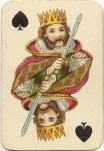 |
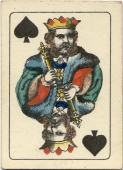 |
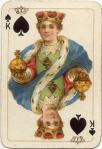 |
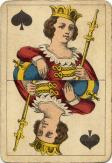 |
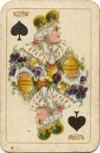 |
| 1 | 2 | 3 | 4 | 5 |
Because playing card manufacturers have always kept a keen eye open for any successful publications by their competitors, it's is likely that the idea of these children's decks was copied by some of the surrounding playing card manufacturers. The oldest documented publication (1) is by Dondorf from Frankfurt, Germany, around 1870, but this doesn't necessarily mean that this was the first publication too. The Austrian deck by Piatnik (2) is not yet fully documented here, neither is the Vass deck (5). The latest deck in this series (3) was available until 1933.
As there are no similar decks found before 1870 or after 1933, we assume that it was a trend, that was only in vogue for a short period, probably in it's high between 1880 and 1910. It also seems that it wasn't picked up by card manufacturers in the rest of Europe, with a possible exception of Denmark. We know that the Dondorf decks (1 and 3) have versions that were made for export to France and England, but haven't seen a French or English made deck (yet). Most of these children's decks are luxury editions. The cards are printed in fine (chromo) lithography on decent playing card carton.
The lithographic techniques are so fine and detailed, that
in this xpo we
will show the courts of the decks at 200%.
YOU CAN SEE THE COURTS OF EACH
DECK BY CLICKING ON ONE OF THE 5 KINGS.
(shown here above in the format that we usually
use on this site: 70% of the original).
ENJOY !
XPOHOME JOKERS EPHEMERA GAMES BARGAINS AGENDA&LINKS